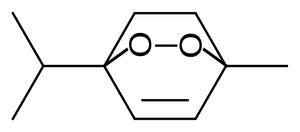Ascaridole
 Structure of ascaridole, somewhat reminding of a person wearing glasses
| |
| Names | |
|---|---|
| IUPAC name
1-Methyl-4-(1-methylethyl)-2,3-dioxabicyclo[2.2.2]oct-5-ene
| |
| Other names
Ascaridol
Askaridol | |
| Properties | |
| Molar mass | 168.23 g/mol |
| Appearance | Colorless liquid |
| Odor | Herb-like |
| Density | 1.010 g/cm3 |
| Melting point | 3.3 °C (37.9 °F; 276.4 K) |
| Boiling point | 130 °C (266 °F; 403 K) (decomposition) 40 °C (104 °F; 313 K) (0.2 mmHg) |
| 0.053 g/100 ml | |
| Solubility | Soluble in acetone, benzene, chloroform, dichloromethane, DMSO, ethyl acetate |
| Hazards | |
| Safety data sheet | BioCrick |
| Except where otherwise noted, data are given for materials in their standard state (at 25 °C [77 °F], 100 kPa). | |
| Infobox references | |
Ascaridole is a naturally-occuring organic compound classified as a bicyclic monoterpenoids that has an unusual bridging peroxide functional group. It has the chemical formula C10H16O2.
The compound is interesting since not only it's a naturally occurring organic peroxide, but it's also an explosive compound derived directly from a biological source (in this case the plant Epazote or Mexican tea).
Contents
Properties
Chemical
Ascaridole will burn if ignited, releasing carbon dioxide, water vapors and soot.
When reacted with sulfuric acid, or reduced with zinc powder and acetic acid, ascaridole formed cymene. Uncontrolled, the reaction may have an explosive outcome.
Physical
Ascaridole is a colorless liquid with a pungent smell and taste that is soluble in most organic solvents.
Explosive
Like other low molecular weight organic peroxides, it is unstable and prone to explosion when heated above 130 °C or treated with organic acids. This however only happens for large amounts and the deflagration is not very powerful.
Availability
Ascaridole is found Chilean tree boldo and is a major constituent of the oil of Mexican tea (wormseed), in case of the latter it comprises up to 70% of the epazote oil.
Preparation
Ascaridole can be prepared by oxidizing α-terpinene with oxygen under UV light and presence of chlorophyll.
Explosions&Fire attempted to grow sufficient Mexican tea plants to extract a useful amount of ascaridole. Witness the results (or lack of) here.
Projects
- Make anthelmintic medication
- Food flavoring
- Make biological-derived energetic compound
Handling
Safety
Ascaridole is toxic and has a pungent, unpleasant smell and taste.
In high doses, epazote oil causes irritation of skin and mucous membranes, nausea, vomiting, constipation, headache, vertigo, tinnitus, temporary deafness and blindness. Prolonged action induces depression of the central nervous system and delirium which transits into convulsions and coma. Long-term effects include pulmonary edema (fluid accumulation in the lungs), hematuria, and albuminuria (presence of red blood cells and proteins in the urine, respectively) and jaundice (yellowish pigmentation of the skin).
Storage
Ascaridole in impure form, like epazote oil can be kept for several months before it decomposes too much in contact with air and light.
Pure ascaridole should be kept in airtight amber bottles, but not for long.
Disposal
Ascaridole can be neutralized with iron(II) sulfate to ascaridole glycol, which is safer to handle and can be diluted with water and poured down the drain.